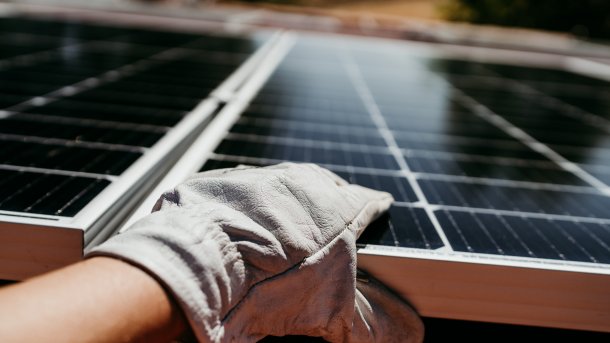New rules for balcony power plants and electricity storage systems
The German government wants to make renewable energies less bureaucratic and more popular – but the devil is still in the detail.

(Bild: eva_blanco / Shutterstock.com)
After months of delays, Solar Package I is set to pass through the Bundestag and Bundesrat in a fast-track procedure on Friday. This should significantly accelerate the expansion of solar energy once again and make it more attractive – including for tenants and balcony power plant operators. However, the latter will have to be careful even after the law has been passed.
After the coalition of the SPD, Greens and FDP had been arguing about individual passages of the Solar Package I legislation since December, they finally announced its completion just over a week ago. One of the major changes to the cabinet version is that the Solar Package I will not include subsidies for photovoltaic manufacturers. The FDP prevailed here, as well as on the question of who must tolerate the laying of power lines for renewable energy systems across their land. While the cabinet version still planned for this to apply to all owners in order to facilitate necessary measures for the energy infrastructure, this is now limited to public sector properties and not all of them either: the German Armed Forces are to be expressly excluded. The FDP, like the CDU and CSU, cited constitutional concerns about the planned far-reaching encroachment on private property rights as an argument.
Plug-in solar systems: waiting for legally compliant 800 watts despite solar package
In recent years, many suppliers of inverters have already provided the option of using software to switch from the upper socket feed-in limit previously permitted in Germany to the internationally standard 800 volt-amperes (VA). In regulatory terms, VA is the relevant measure of all things. This is because legislation and operational safety are concerned with how much electricity is fed into the grid and at what strength.
For most plug-in solar systems, the solar package now removes the restriction to 600 volt-amperes, which was previously the legal limit. Instead, the government draft and the coalition's agreement introduce a separate device class with a maximum limit of 800 volt-amperes and a maximum installed output of 2 kilowatts for the Renewable Energy Sources Act. However, the will of the legislator alone is not enough to provide definitive clarity for users. A new standard should create reliability here. The changes to the Renewable Energy Sources Act are rather an additional classification, which is primarily intended to reduce bureaucratic obligations.
For operators of a plug-in solar system, this will make many things easier in future. The Federal Network Agency had already simplified the registration procedure at the beginning of April, and with Solar Package I this will now be streamlined once again - from the time it comes into force, balcony power plants will no longer have to be registered with the grid operator by law, but only in the market master data register with the supervisory authority. In the case of a full feed-in as an EEG system into the general electricity grid, however, nothing will change, including all associated obligations.
According to a spokesperson for the Federal Network Agency, however, "the legal situation that applied at the time of commissioning applies in principle." This means that anyone who has already plugged in their small power plant must legally follow the old rules here too – anyone who is still considering purchasing and connecting should wait for the formal entry into force, which is due to take place in just a few days. This is because the Bundesrat will probably also wave through the Solar Package I on Friday immediately after it has been passed by the Bundestag, after which the Federal President will have to officially sign it off – the changes will then come into force once they have been published in the Federal Law Gazette.
Beginning of May: New draft standard for plug-in solar systems
However, even after the solar package, an important technical standard is still missing for the legally unobjectionable feed-in of electricity for personal consumption from small solar systems with more than 600 volt-amperes: for months, experts have been discussing which technical requirements plug-in solar systems must meet for safe operation, even with higher feed-in power. Until now, manufacturers have had to provide individual proof that their components are safe – and if various components are combined to form a system, an electrician would in principle have to approve the plug-in solar system. Otherwise, operators may be exposed to safety and liability risks.
The responsible committee at the German Commission for Electrical Engineering (DKE) presented an initial proposal for a product standard last year, which was met with many objections. The standard would reverse the presumption rule: a plug-in solar system would be considered safe if it complied with the standard. A second draft is now to be published on May 3, which can also be commented on. This should address key questions, such as whether an earthing contact plug is sufficiently safe or whether a Wieland plug should be mandatory.
This process will then take another two months before the standard is adopted and manufacturers can refer to it. For consumers, this would provide simple clarity, especially for complete packages. In reality, however, this increase in the limit is only likely to help significantly increase the actual yield in very good conditions - but the cost of the changeover for many providers is also low. In reality, however, this hardly plays a role: 800 VA has long since established itself on the market. The Federal Network Agency expressly warns that "for systems with the option of switching between different power values, the highest switchable power is always relevant". Anyone whose system could feed in more would therefore also fall outside the new plug-in solar rules of the EEG.